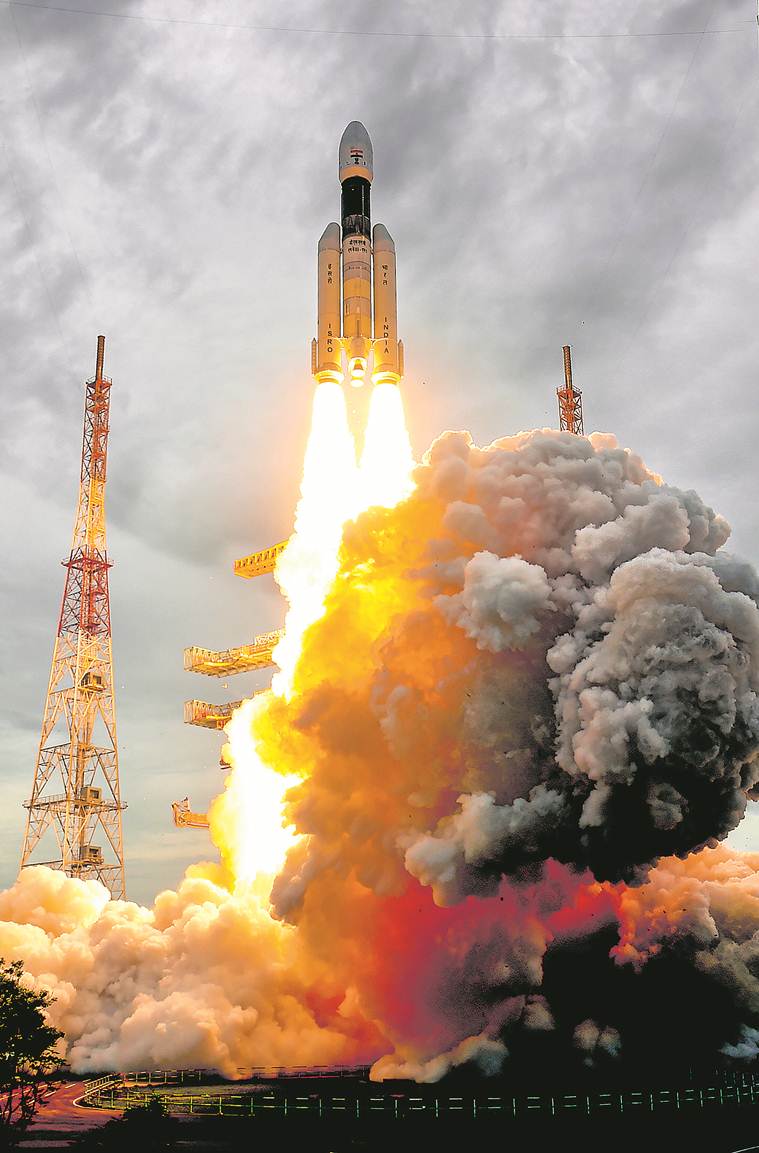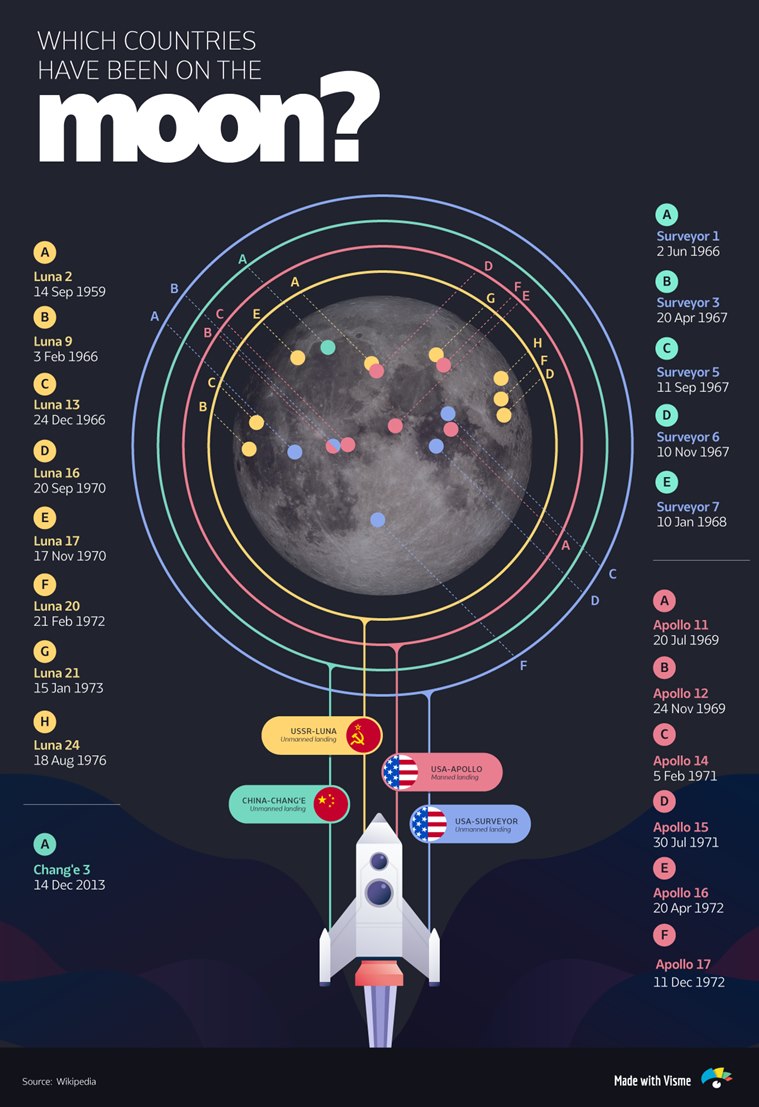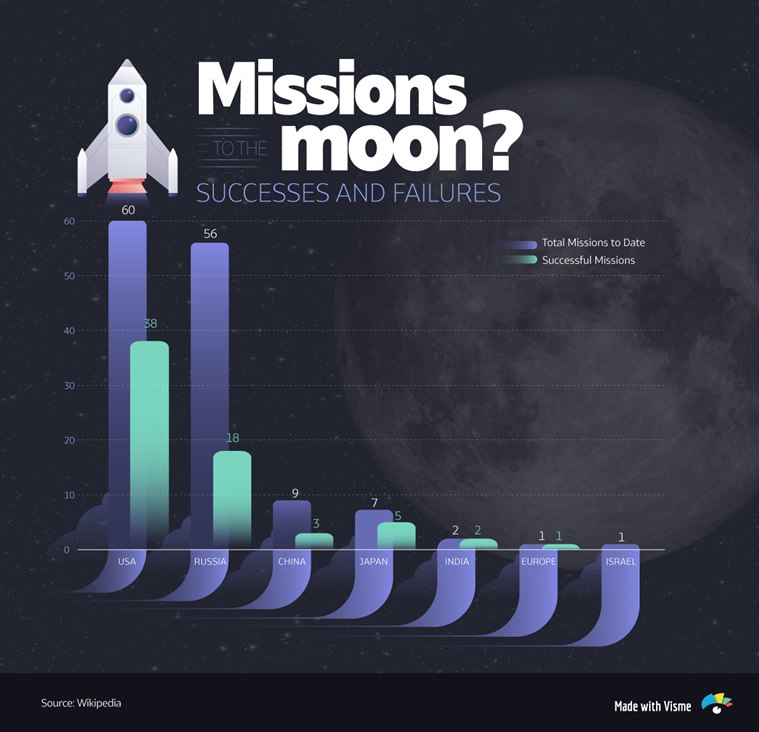
Carrying “a billion dreams” in India’s quest to land its first spacecraft on the moon, Chandrayaan-2, riding the powerful GSLV Mk-III rocket, was successfully launched at 2.43 pm Monday from the Satish Dhawan Space Centre at Sriharikota.
It was a textbook launch and initial anxiety evaporated 16 minutes 23 seconds later when scientists at mission control broke into applause, signalling that Chandrayaan-2 was now on its own. It had been deposited in an earth orbit by the 640-tonne GSLV Mk-III which, after burning its successive stages, had separated itself completely from the spacecraft. The orbit at its nearest was 170 km from earth, and 39,120 km at the furthest.
READ | These are the crucial phases of the mission
The mission will see the Vikram lander and Pragyan rover modules of the spacecraft make a soft-landing near the unexplored south pole of the lunar surface 48 days from now — on September 7. Both will be “alive” there for 14 days, during which they will carry out various experiments and collect data.
The mission also has an orbiter module that will go around the moon for the next one year in an orbit of 100 km from the lunar surface. During this time, instruments on board the orbiter will study the moon’s surface, its atmosphere, prepare three-dimensional maps, and also search for further evidence of water, including the possibility of ice trapped in the south pole craters.
ALSO READ | Chandrayaan-2 in earth orbit, now all eyes on September 7 moon landing
The launch Monday went off without any hitch, a week after it was aborted 56 minutes before liftoff due to a technical snag. Chandrayaan-2 will spend the next 23 days circling around the earth, incrementally raising its orbit, before embarking on a seven-day journey to enter an orbit around the moon.
The celebration in mission control was held back till the final separation of the spacecraft and the rocket. “Today is a historic day for space and science and technology in India. I am extremely happy to announce that that GSLV Mk-III has successfully injected Chandrayaan-2 in desired orbit,” ISRO chairman K Sivan said minutes later.

Prime Minister Narendra Modi took to Twitter to congratulate ISRO: “The launch of #Chandrayaan2 illustrates the prowess of our scientists and the determination of 130 crore Indians to scale new frontiers of science. Every Indian is immensely proud today!… Our existing knowledge of the Moon will be significantly enhanced.”
President Ram Nath Kovind, who was supposed to witness the original launch on July 15, also congratulated the team. “The historic launch of #Chandrayaan2 from Sriharikota is a proud moment for all Indians. Congratulations to our scientists and engineers for furthering India’s indigenous space programme May @ISRO continue to master new technologies, and continue to conquer new frontiers,” he said in a message posted on Twitter.
While the Chandrayaan-2 mission still has a long way to go, scientists had the satisfaction of seeing the GSLV Mk-III rocket, ISRO’s launch vehicle for the future, complete its job successfully on its maiden operational flight.
The GSLV Mk-III, which has an interesting history of how technology denial impeded India’s progress in space, has taken ISRO decades to build. Meant to carry heavy spacecraft, in the range of 4000 to 6000 kg, deeper into space, GSLV Mk-III had earlier completed an experimental flight and two development flights. Chandrayaan-2 is its most important mission so far.
“The launch vehicle was also special for this mission. In this mission, the performance of GSLV Mk-III has been increased by 15 per cent compared to earlier missions,” Sivan said.

“Actually, it is just the beginning of India’s historic journey towards the moon, and to land at a place near the south pole (of the moon) to carry out scientific experiments to explore the unexplored,” he said.
Sivan congratulated the mission team for recovering quickly from last week’s setback and applying corrective action in quick time.
“ISRO has bounced back with flying colours. Immediately after the technical snag was observed (on July 15), we pulled it (the mission) back, and the entire Team ISRO swung into action. The work done in the next 24 hours at this centre (Satish Dhawan Space Centre) was mind boggling. The launch vehicle was quickly brought back to normal. Everything happened in just 24 hours. In the next one and half days, the required tests were conducted to ensure that the corrections made were proper, the right corrections… and we confirmed that. The mammoth task was accomplished due to very hard work put in by Team ISRO,” he said.
Chandrayaan-2 is attempting to become the first spacecraft to land near the lunar south pole. All 28 previous landings on the moon, including human landings, have happened in and around the equatorial region. Recent studies, however, point to a greater science potential in exploring the polar regions of the moon. This region is supposed to be filled with small and large craters, ranging from a few centimetres in size to those extending to several thousands of kilometres (these craters make it extremely hazardous for a spacecraft to land here). This region is also extremely cold, with temperatures in the range of minus 200 degree Celsius.
Unlike the earth, the moon does not have a tilt around its axis. It is almost erect, because of which some areas in the polar region never receive sunlight. Anything here remains frozen, almost for eternity. Scientists believe that rocks found in these craters could have fossil records that can reveal information about the early solar system. In addition, there is also evidence of large amounts of ice trapped in the craters of this region.